A 1 × 4 Silica-Based GMZI Thermo-Optic Switch with a Wide Bandwidth and Low Crosstalk
Abstract
1. Introduction
2. Design and Simulation
3. Fabrication and Characterizing
4. Discussion
5. Conclusions
Funding
Institutional Review Board Statement
Informed Consent Statement
Data Availability Statement
Acknowledgments
Conflicts of Interest
References
- Masrom, M.; Krisnan, L.; Yahya, Y.; Kaundan, M.K. Patient Attitude on the Application of Artificial Intelligence in Diabetes Care. In Proceedings of the 2024 5th International Conference on Artificial Intelligence and Data Sciences (AiDAS), Bangkok, Thailand, 3–4 September 2024; pp. 441–445. [Google Scholar]
- Yoo, S.B. Prospects and challenges of photonic switching in data centers and computing systems. J. Light. Technol. 2021, 40, 2214–2243. [Google Scholar] [CrossRef]
- Zeng, Z.; Du, Y.; Qian, Y.; Liu, M.; Chen, C. Index modulation multiple access-aided multi-user VLC for Internet of Medical Things. Opt. Express 2024, 32, 44478. [Google Scholar] [CrossRef]
- Sasikala, V.; Chitra, K. All optical switching and associated technologies: A review. J. Opt. 2018, 47, 307–317. [Google Scholar] [CrossRef]
- Xu, X.; Zhang, D.; Zhang, P.; Tang, B.; Yin, Y. Multilayer Reconfigurable 3D Photonics Integrated Circuits Based on Deposition Method. Laser Photonics Rev. 2025, 19, 2400827. [Google Scholar] [CrossRef]
- Tsai, C.; Tsai, J. MEMS optical switches and interconnects. Displays 2015, 37, 33–40. [Google Scholar] [CrossRef]
- Kovaios, S.; Tsakyridis, A.; Giamougiannis, G.; Fotiadis, K.; Sacchetto, D.; Zervas, M.; Moralis-Pegios, M.; Pleros, N. Generalized Mach Zehnder Interferometers Integrated on Si3N4 Waveguide Platform. IEEE J. Sel. Top. Quantum Electron. 2023, 29, 1–9. [Google Scholar] [CrossRef]
- Xie, Z.; Bo, F.; Lin, J.; Hu, H.; Cai, X.; Tian, X.-H.; Fang, Z.; Chen, J.; Wang, M.; Chen, F.; et al. Recent development in integrated Lithium niobate photonics. Adv. Phys. X 2024, 9, 2322739. [Google Scholar] [CrossRef]
- Zhang, S.; Yin, Y.; Wang, Z.; Li, Y.; Zhang, Y.; Yao, M.; Zhang, D.; Li, Y. Low-Power-Consumption and Broadband 16-Channel Variable Optical Attenuator Array Based on Polymer/Silica Hybrid Waveguide. Photonics 2024, 11, 547. [Google Scholar] [CrossRef]
- Ding, Y.; Zhang, D.; Zhang, P.; Tang, B.; Wang, F.; Wang, X.; Yokoyama, S.; Yin, Y. Dual-mode 2 × 2 electro-optic switch on a SOI platform. Opt. Lett. 2024, 49, 6125. [Google Scholar] [CrossRef] [PubMed]
- Zhang, Y.; Yin, Y.; Ding, Y.; Zhang, S.; Sun, X.; Zhang, D.; Li, Y. On-Chip E00–E20 Mode Converter Based on Multi-Mode Interferometer. Micromachines 2023, 14, 1073. [Google Scholar] [CrossRef] [PubMed]
- Seok, T.J.; Kwon, K.; Henriksson, J.; Luo, J.; Wu, M.C. Wafer-scale silicon photonic switches beyond die size limit. Optica 2019, 6, 490. [Google Scholar] [CrossRef]
- Lee, B.G.; Rylyakov, A.V.; Green, W.M.J.; Assefa, S.; Baks, C.W.; Rimolo-Donadio, R.; Kuchta, D.M.; Khater, M.H.; Barwicz, T.; Reinholm, C.; et al. Monolithic Silicon Integration of Scaled Photonic Switch Fabrics, CMOS Logic, and Device Driver Circuits. J. Light. Technol. 2014, 32, 743–751. [Google Scholar] [CrossRef]
- Dupuis, N.; Lee, B.G.; Rylyakov, A.V.; Kuchta, D.M.; Baks, C.W.; Orcutt, J.S.; Gill, D.M.; Green, W.M.J.; Schow, C.L. Modeling and Characterization of a Nonblocking 4 × 4 Mach–Zehnder Silicon Photonic Switch Fabric. J. Light. Technol. 2015, 33, 4329–4337. [Google Scholar] [CrossRef]
- Pan, S.; Yao, J. UWB-Over-Fiber Communications: Modulation and Transmission. J. Light. Technol. 2010, 28, 2445–2455. [Google Scholar] [CrossRef]
- Wei, J.; He, Y.; Yang, Y.; Ding, J.; Lu, L.; Zhu, L. Lightweight optical neural network based on micro-ring resonator. Opt. Express 2025, 33, 10674. [Google Scholar] [CrossRef]
- Zeng, G.; Zhang, D.; Wang, F.; Wang, X.; Yin, Y. 1 × N All-Logic Optical Switch Based on Polymer Platform Using Multimode Interferometer. Adv. Photonics Res. 2024, 6, 2400118. [Google Scholar] [CrossRef]
- Wang, J.; Niu, H.; Cheng, W.; Shi, S.; Chen, Y.; Guo, C.; Zhu, W.; Hu, G.; Cui, Y.; Yun, B. Compact and power-efficient 3 × 3 silicon photonic interferometer thermo-optic switch. Opt. Express 2025, 33, 12475. [Google Scholar] [CrossRef]
- Wang, M.; Yue, J.; Yao, Z.; Liu, T.; Sun, X.; Wu, Y.; Zhang, D. Low-power and wide-band 1 × 8 silica waveguide optical switch. Opt. Laser Technol. 2024, 171, 110380. [Google Scholar] [CrossRef]
- Yue, J.; Wang, M.; Zou, J.; Liu, T.; Fang, J.; Sun, X.; Wu, Y.; Zhang, D. Low-loss silica waveguide 1 × 8 thermo-optic switch based on large-scale multimode interference couplers. Opt. Commun. 2024, 573, 131014. [Google Scholar] [CrossRef]
- Gao, F.; Xie, W.; Tan, J.Y.S.; Leong, C.; Li, C.; Luo, X.; Lo, G.-Q. Comprehensive Investigation of Thermo-Optic Phase Shifters on a Multi-Layered SiN-on-SOI Platform. J. Light. Technol. 2023, 41, 3108–3114. [Google Scholar] [CrossRef]
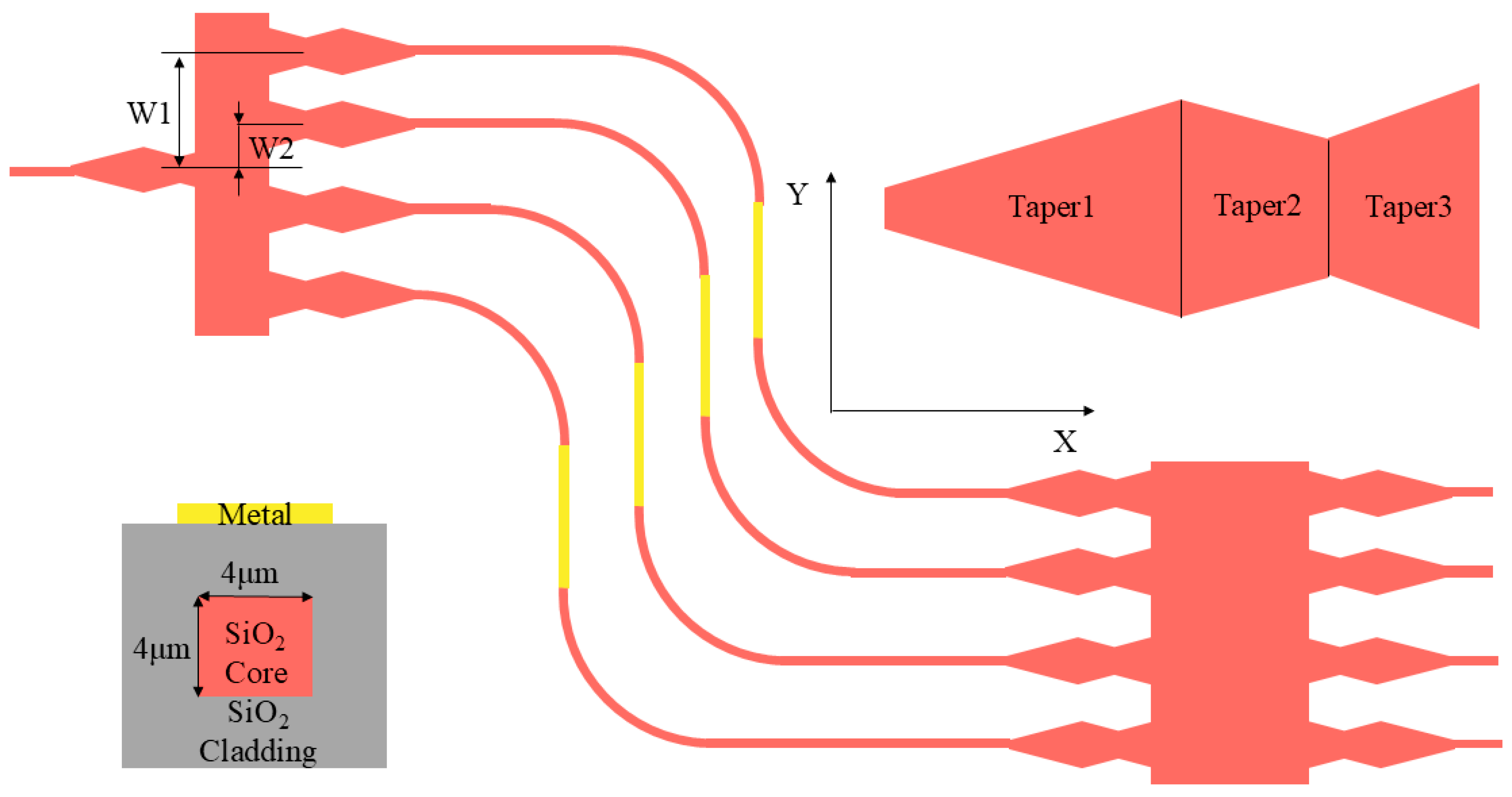
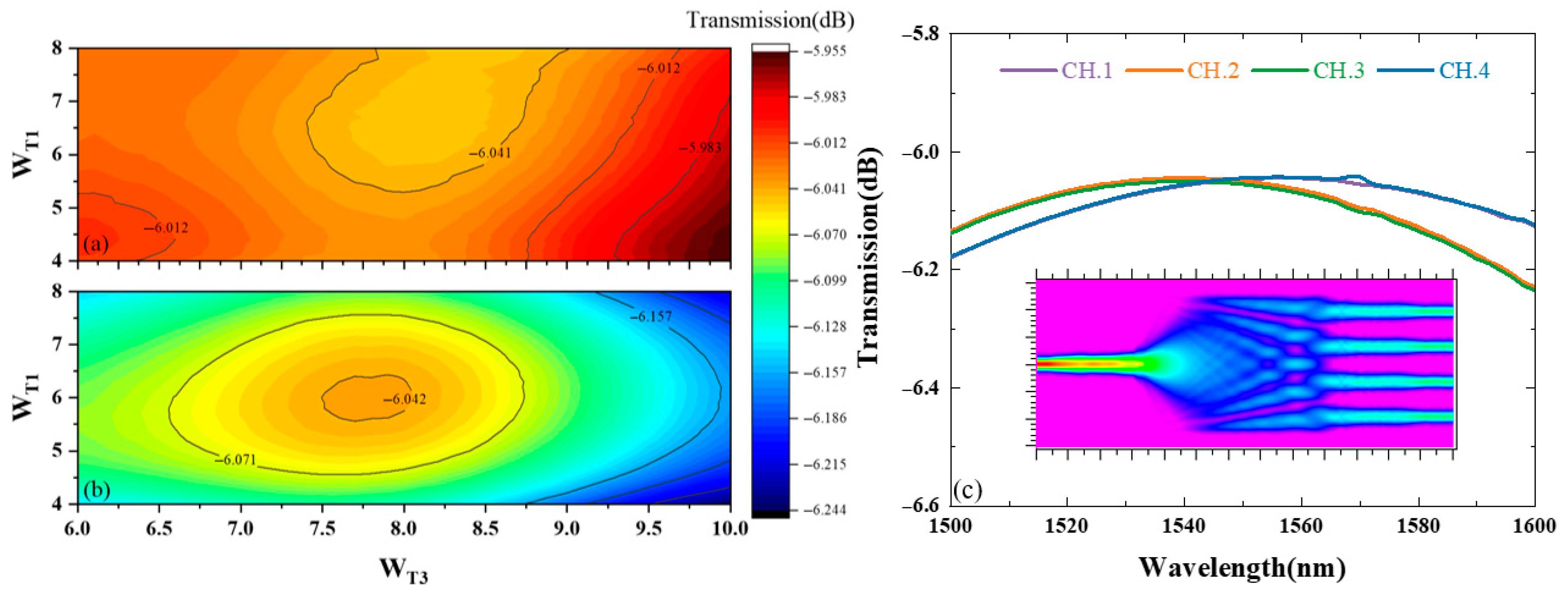
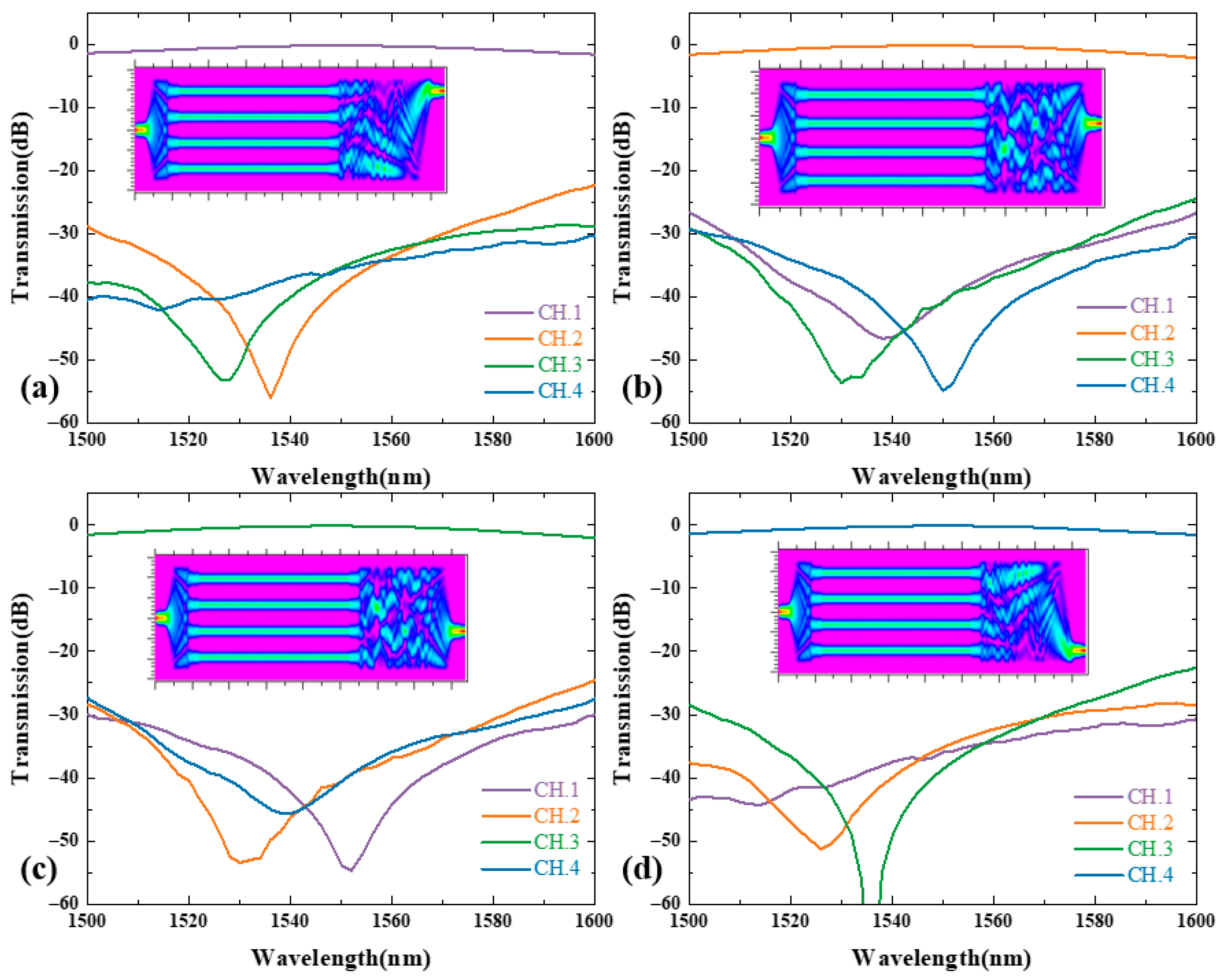
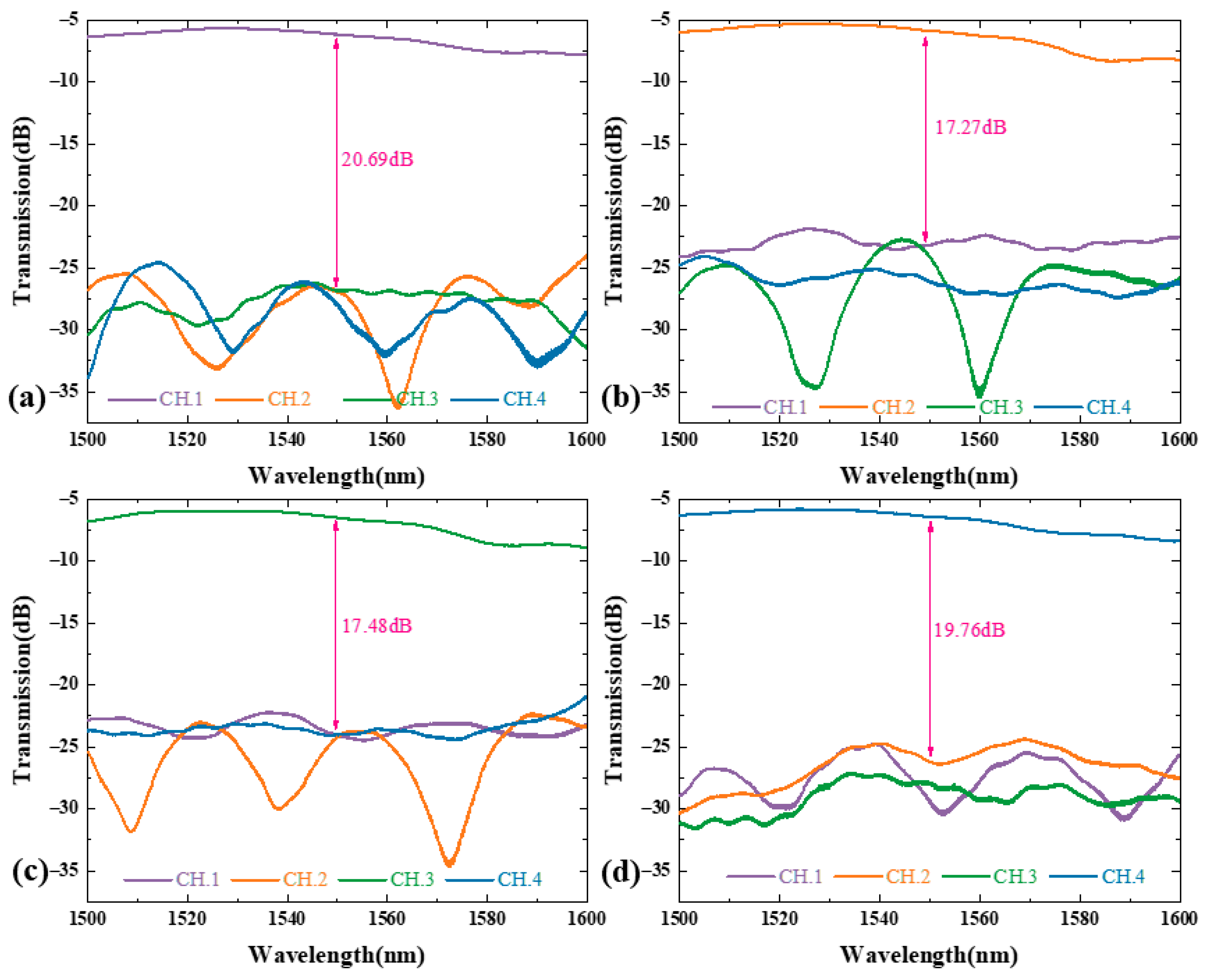
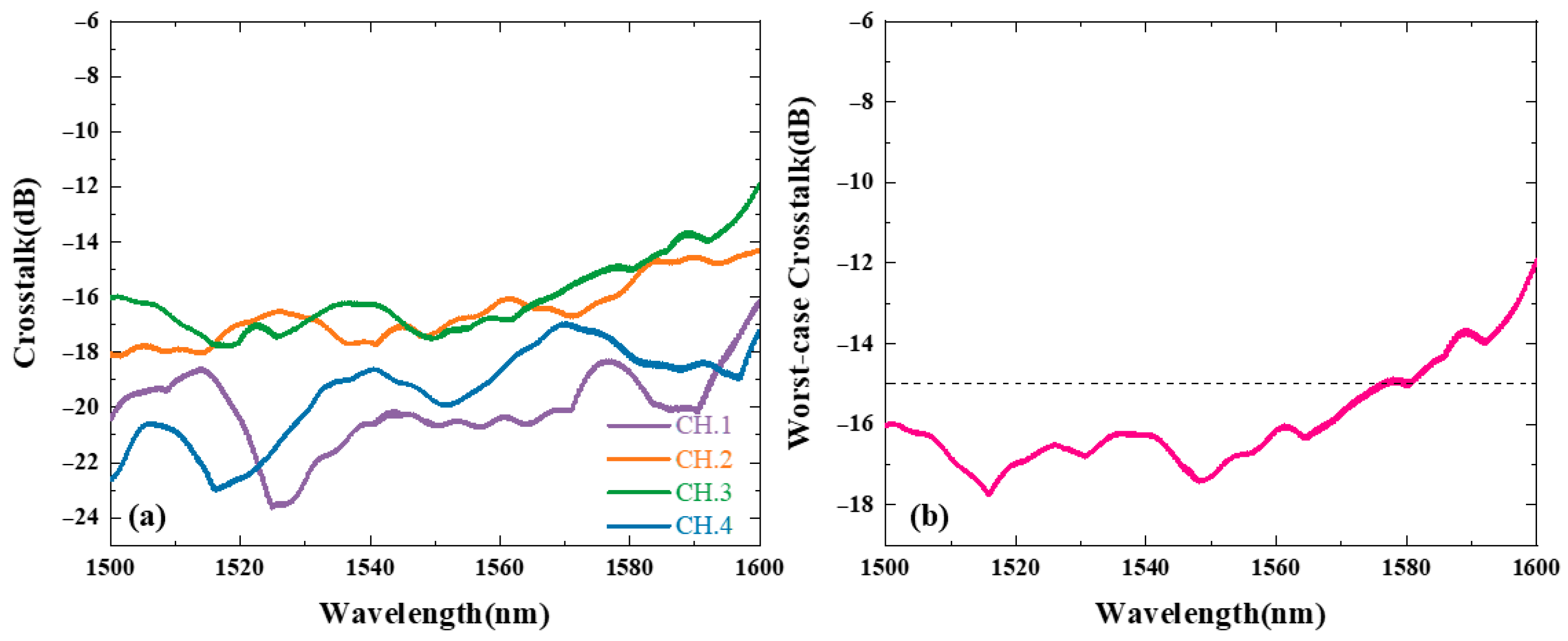
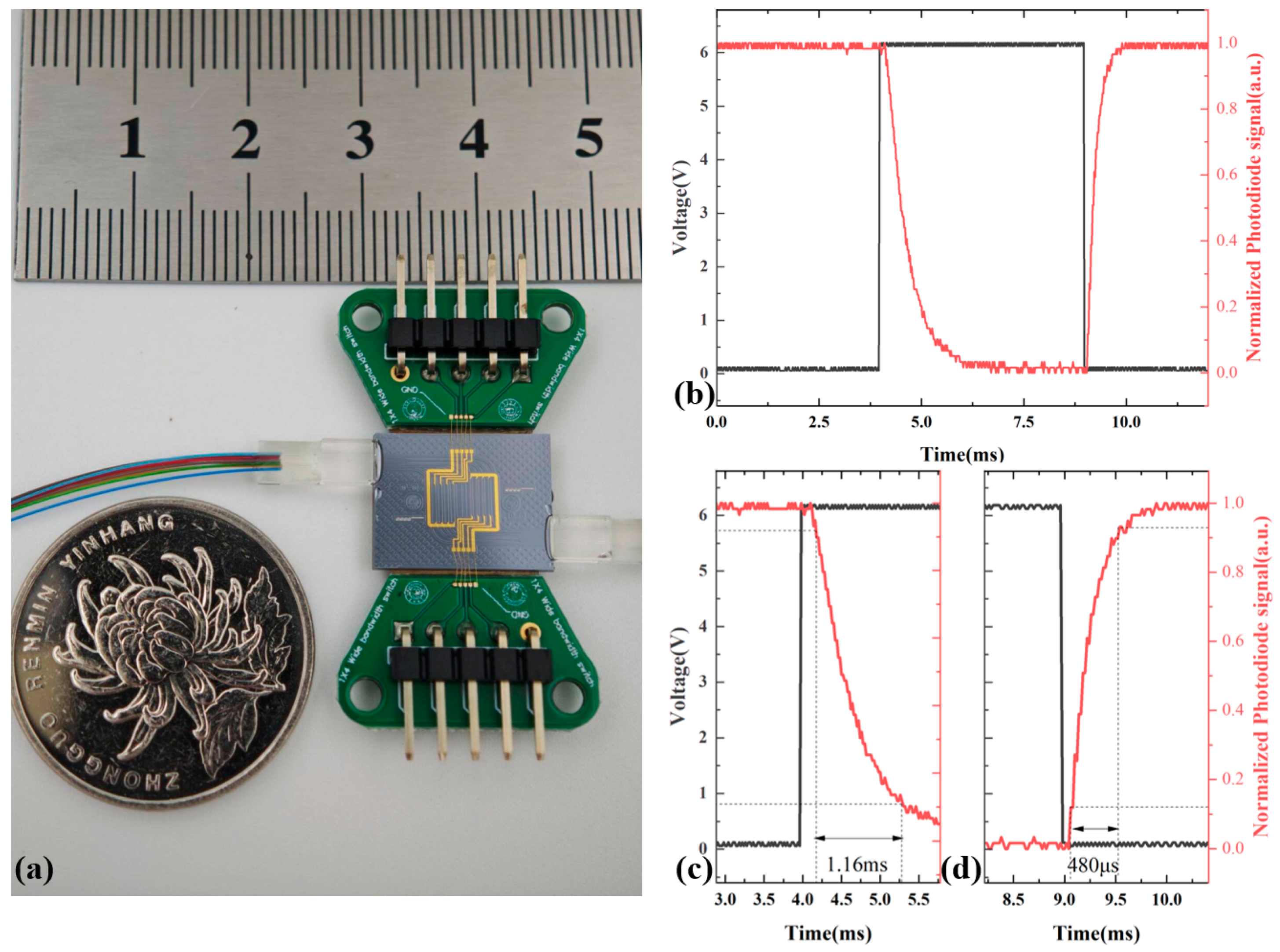
| Dimension | W1 × 4 mmi | L1 × 4 mmi | W4 × 4 mmi | L4 × 4 mmi | WT1 | WT2 | WT3 | LT | W1 | W2 |
| Value (μm) | 50 | 635 | 50 | 2546 | 6.3 | 6.2 | 8 | 90 | 6.45 | 19.39 |
| Output Status | Power Consumption (mW) | IL of CH.1 (dB) | IL of CH.2 (dB) | IL of CH.3 (dB) | IL of CH.4 (dB) |
|---|---|---|---|---|---|
| Output1 | 0, 317.99, 689.69, 6.73 | −6.15 | −26.89 | −26.85 | −27.99 |
| Output2 | 471.22, 42.05, 0, 42.05 | −23.14 | −5.87 | −24.16 | −26.17 |
| Output3 | 0, 0, 417.22, 0 | −24.06 | −24.11 | −6.51 | −23.99 |
| Output4 | 0, 623.25, 168.19, 0 | −29.48 | −26.18 | −27.85 | −6.42 |
| Ref. | Port | Platform | IL (dB) | XT (dB) | Power (mW) | Footprint (mm2) | Speed (ms) | Bandwidth (nm) |
|---|---|---|---|---|---|---|---|---|
| [18] | 3 × 3 | SOI | −3.3 | −13 | 4.6 | 0.4 | / | 30 |
| [7] | 4 × 4 | SI3N4 | <−3 | <−8 | 370 | 2 × 1.35 | <10 | / |
| [17] | 1 × 4 | Polymer | −23.7 | −10 | 85.92 | 8.7 × 5.21 | 0.38/0.36 | 35 |
| [19] | 1 × 8 | Silica | −3.4 | <−15.7 | 315.8 a | 25.85 × 1.75 | 0.94/1.04 | 120 |
| [20] | 1 × 8 | Silica | −3.69 | −16.29 | 1830 a | 18.67 × 1.75 | 1.0/1.24 | 2 |
| This work | 1 × 4 | Silica | −6.51 | −17.27 | 1014.41 | 15.76 × 0.86 | 0.48/1.16 | 100 |
Disclaimer/Publisher’s Note: The statements, opinions and data contained in all publications are solely those of the individual author(s) and contributor(s) and not of MDPI and/or the editor(s). MDPI and/or the editor(s) disclaim responsibility for any injury to people or property resulting from any ideas, methods, instructions or products referred to in the content. |
© 2025 by the author. Licensee MDPI, Basel, Switzerland. This article is an open access article distributed under the terms and conditions of the Creative Commons Attribution (CC BY) license (https://creativecommons.org/licenses/by/4.0/).
Share and Cite
Wang, Y. A 1 × 4 Silica-Based GMZI Thermo-Optic Switch with a Wide Bandwidth and Low Crosstalk. Photonics 2025, 12, 721. https://doi.org/10.3390/photonics12070721
Wang Y. A 1 × 4 Silica-Based GMZI Thermo-Optic Switch with a Wide Bandwidth and Low Crosstalk. Photonics. 2025; 12(7):721. https://doi.org/10.3390/photonics12070721
Chicago/Turabian StyleWang, Yanshuang. 2025. "A 1 × 4 Silica-Based GMZI Thermo-Optic Switch with a Wide Bandwidth and Low Crosstalk" Photonics 12, no. 7: 721. https://doi.org/10.3390/photonics12070721
APA StyleWang, Y. (2025). A 1 × 4 Silica-Based GMZI Thermo-Optic Switch with a Wide Bandwidth and Low Crosstalk. Photonics, 12(7), 721. https://doi.org/10.3390/photonics12070721




